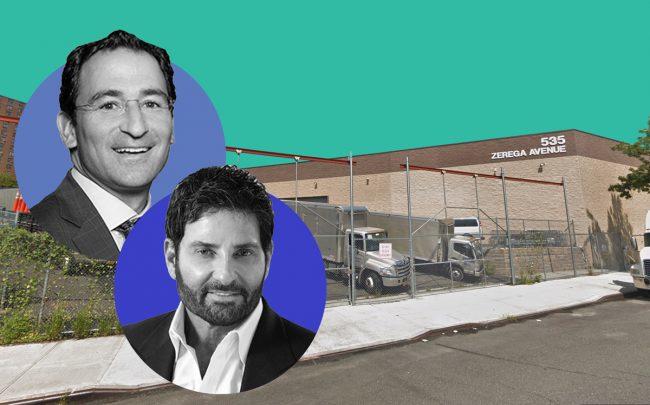Jeremy Liebler spent four years working in sales and marketing at Ford Motor Company before he made the switch to real estate. He could have looked for work as a junior staffer on a top-agent team, where someday he might appear on an episode of “Million Dollar Listing: New York.” Or he could have put in the grueling hours needed to one day broker a trophy office tower deal in Manhattan, a la Darcy Stacom or Doug Harmon. But he chose what has traditionally been a far-less glamorous option.

Jeremy Liebler of JLL
“It really seemed like industrial had the most runway and growth,” said the 29-year-old JLL broker, “so I thought that would be a good place to be for a few years – for at least the five-year plan.”
Liebler is among the growing contingent of brokers in the tri-state area who are eschewing the flashier, more traditional corners of brokerage that had long been the training grounds for thousands of ambitious agents. Instead, they’re touring warehouses in gritty corners of New York, New Jersey and Connecticut; frantically texting investors of all shapes and sizes; and closing deals in under a week.

From left: Blackstone’s Jonathan Gray, Joseph Simone of Simone Development and 535 Zerega Avenue in the Bronx (Credit: Google Maps, Simone Development)
Few things are more exciting in real estate than money, and for many brokers, industrial is where the money is.

Joshua Kleinberg of Cushman & Wakefield
“Who would have thought some young kids out of college would come in and say, ‘We’re going to be industrial brokers in the outer boroughs,’” said Joshua Kleinberg, an industrial broker at Cushman & Wakefield. “Five years ago, those guys were all wanting to be retail brokers. Before that, they were all wanting to be office brokers. The young guys coming out of college right now all want to be industrial brokers.”
Need for Speed

Thomas Donovan of B6 Real Estate Advisors
Thomas Donovan, a vice chairman at B6 Real Estate Advisors with years of experience marketing industrial properties, was at a low-slung, 5,000-square-foot warehouse in Woodside, Queens in January 2018 when he got word from the client: name the seller’s asking price so the investors could close as soon as humanly possible.
“They waived all due diligence and just said, ‘I’ll close it next week as long as I know it’s mine,’” he said. “The 5- to 10,000-square-foot spaces for sale were that hard to come by.”
Moving that quickly is oftentimes the only way a company can ensure it gets the industrial property it really wants, brokers said.
Adam Citron, an industrial broker at JLL, said high demand has made it much more common for buyers to settle on their third or fourth choices for warehouses.
“It doesn’t always mean it’s the fourth best out of four choices,” he said. “It just means that new opportunities come along often, but they also are leased or sold just as often.”
This happened last year when a large New York City-based nonprofit hired JLL to find a suitable industrial space. While JLL was ultimately able to find something for the nonprofit, it took several failed efforts.
“There was likely a minimum of three other pursuits that had not gone the way that we wanted them to go, given market availability,” he said.
Pound the pavement, cash the check
High demand has changed the range of the client base and the pace of deals, but brokers still rely primarily on tried-and-true techniques – door knocks, phone canvassing and existing client referrals – to land assignments and win new business.

CenterPoint CEO Bob Chapman, 101-01 Avenue D (top) and 103-00 Foster Avenue (Credit: Google Maps)
And the brokers make their money in fairly standard ways as well, earning fees and commissions that top out around 5 percent, but tick down on much larger deals.
Industrial developers rely on broker counterparts to not just know the market, but to understand supply chains and potential new uses of space.
“We’re getting more sophisticated tenants, and the leasing process has also gotten more complicated, so we’re busier,” said Kleinberg. “We’re dealing with more institutional ownership.”
The rise of the industrial broker coincides with the phenomenal growth of e-commerce and the need for “last-mile” warehouses on the edges of major urban centers.
In 2014, national sales volume for industrial assets was $50.4 billion, according to research by Newmark Knight Frank. In 2019, that number exploded to $112.1 billion. Locally, demand has also roughly doubled. In 2014, industrial volume in the New York metropolitan area was $4.6 billion, but it rose to $8.4 billion last year, according to Newmark.
New York City alone saw $1.7 billion worth of deals across 296 industrial properties last year at an average price of $393 per square foot, which all marked significant increases from 2018, according to Cushman & Wakefield. Vacancy rates for industrial properties in the outer boroughs were all low during the year’s fourth quarter, ranging from just 3.1 percent in Staten Island to 5.4 percent in the Bronx, the firm reported.
The vacancy rate in Long Island was similarly low in the fourth quarter at 4.8 percent, and it was even lower in New Jersey at 2.8 percent, according to Cushman. New Jersey’s Middlesex County saw the most leasing activity by a wide margin at about 13.3 million square feet.
The trend has extended far beyond the New York metro area. Availability rates for industrial space across the country was just 7.2 percent as of the fourth quarter of 2019, according to CBRE.

Brad Pope of JLL
“Twenty-five years ago, it wasn’t a very sexy topic,” said Brad Pope, a JLL industrial broker based in Atlanta. “[But] there’s always demand where there’s money, so if there’s money to be made, people will show up.”
You can call it the Amazon effect. The online retail giant’s insatiable desire for warehouse space has helped transform a formerly niche market into one that young brokers cannot ignore, according to Pope.
“I just fell into this business by accident,” he said. “Today, pretty much every business student in college is aware of Amazon’s supply chain. It just wasn’t the case 25 years ago.”

Kevin Dudley of CBRE
However, those trying to break into the industrial brokerage game might now find themselves caught in a catch-22, according to Kevin Dudley, an industrial broker at CBRE. They want to put together industrial deals because industrial properties are so popular, but because industrial properties are so popular, they will likely have a harder time finding vacant assets to sell.
“It’s a tough industry to break into right now because the vacancy rate in top markets like New Jersey is below 2 percent,” he said. “When I started, we were at like 9 percent in New Jersey. There was a lot of opportunity.”
And it isn’t just younger brokers who are paying more attention to the industrial market these days. Kleinberg said he now faces competition for properties from companies both large and small, which was not the case at the beginning of his career.
“When I started, the JLLs weren’t showing my properties,” he said. “Now, from the mom and pops to the multinational companies, everybody wants a piece. Everybody wants to get involved with industrial.”
No end in sight
Most industrial brokers did not solely attribute the popularity of warehouse properties to the e-commerce boom, noting that other factors ranging from a strong economy to a lax regulatory environment compared to other types of properties played a role as well.
But there was near universal agreement that it had given a massive boost to the industry. This is especially true given that online retailers generally need a very large amount of space compared to other types of clients, according to Pope.

Prologis CEO Hamid Moghadam and 18-51 Flushing Ave. (Credit: Google Maps, iStock)
“It takes two-and-a-half to three times the amount of warehouse space to support the same sales to consumers on the e-commerce model versus the brick and mortar model,” he said, “so as e-commerce takes a larger and larger share of retail sales overall, the demand for warehouse space increases exponentially.”
E-commerce has shifted the way companies view industrial properties as well, brokers said. They are no longer just looking for a property where they can store their goods but for a property that will serve as a key asset in their business model.
“People aren’t just looking for warehouses,” Dudley said. “They’re looking for things like network optimization and supply chain and how that fits into the whole piece.”
“If you can’t deliver your goods to anywhere in the world for a reasonable cost in a timely fashion,” he continued, “then it doesn’t matter how great of a product you have.”
Kyle Eaton, an industrial broker at Newmark, said he is “100 percent busier” today than he was even just a few years ago, and while e-commerce may not be the only reason for this, he expects the sector to stay busy for the foreseeable future.
“As long as people are shopping online and e-commerce stays healthy,” he said, “this is going to continue.”
